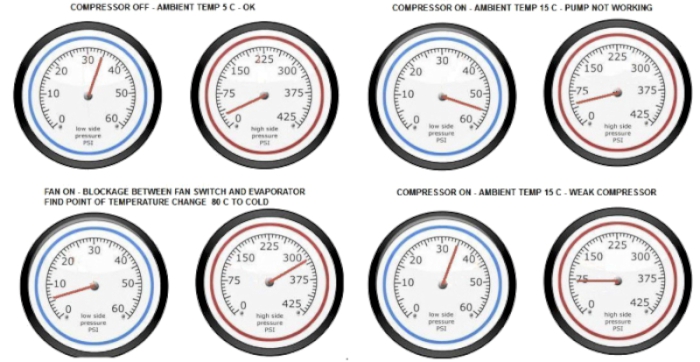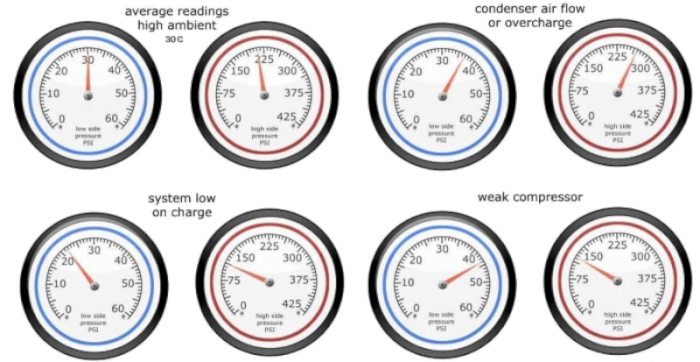PRESSURE GAUGE READINGS
copied from this Aircon Machine Services page
UNDERSTANDING YOUR GAUGES

If you do not understand the gauges you do not understand air conditioning. This is a basic introduction to gauge reading which is relevant to most vehicles but not all and as such it should only be used as a guide. The vehicle should be recovered, vacuumed and charged prior to testing.
When reading your gauges there are a couple of basic facts that should be considered
1. AMBIENT TEMPERATURE
The system should be recovered, vacuumed (min 20 minutes) and charged. The gauges readings will depend on the ambient temperature.
With the A/C turned OFF - On a cold day the pressure will be low, on a hot day the pressure will be high. The table below shows the comparison between temperature and pressure for R134a.
2. AIR CONDITIONING OFF
| AMBIENT TEMP ºC |
R134a PRESSURE psi |
| 0 | 30 |
| 10 | 45 |
| 15 | 55 |
| 20 | 70 |
| 25 | 80 |
| 30 | 100 |
| 35 | 115 |
| 40 | 130 |
As the ambient temperature rises the red gauge rises (40psi up to 225psi) and the blue gauge remains at a constant low (20psi to 35psi). The red gauge stops increasing as the fan cuts in, typically between 180psi and 225psi.
CONTROL SYSTEM
MANUAL CONTROL
The compressor is either on full or off (the familiar clicking sound as the compressor engages). This is controlled by a temperature sensor, when the system is cold enough the compressor turns off, as the temperature increases the compressor turns on.
The gauge readings will be as above when the pump turns on and off.
AUTOMATIC CLIMATE CONTROL
Initially the compressor is on full, when it reaches the required temperature, it will reduce the amount of refrigerant being pumped through the system (there is no clutch plate to click on or off, it is internally regulated). This is controlled via sensors through the ECU.
The gauge readings will initially be as above; however when the vehicle reaches the required temperature the compressor will pump less refrigerant around the system. When less refrigerant is being pumped the pressure on the red gauge will be lower.
| AMBIENT TEMP ºC |
RED GAUGE psi |
BLUE GAUGE psi |
| 0 | 30 - 40 | 20 - 30 |
| 10 | 40 - 60 | 20 - 30 |
| 20 | 60 - 120 | 20 - 30 |
| 30 | 120 - 150 | 25 - 35 |
| 40 | 150 - 180 | 25 - 35 |
In cool weather, once the required temperature is reached, the red gauge will barely increase, this may give the impression that the compressor is not pumping, even though it is.
Examples of Faults
1. If neither gauge moves, the compressor is not pumping. Possible faults include – fuse, pressure sensor, fan belt slipping, relay, wiring break, no gas, compressor fault.
2. If the compressor is pumping against a blockage the red gauge will be too high. If there is a blockage on the suction side of the compressor (blue gauge) the pressure will fall. Possible faults include – blocked filter, crushed pipe, too much gas/oil, thermal expansion valve blocked.
Remember, as the pressure increases the temperature also increases, so the pipes/filter etc will be HOT up to the point of the blockage and COLD (possible freezing) straight after the blockage.
1. If the red gauge is over 225psi check if the fan is working. Possible fan switch fault, this may be a single switch near the condenser or combined with the pressure switch (if it has 4 wires).
2. Poor cooling in the vehicle. Possible faults include all the above and possibly – condenser air flow restricted, vacuum time too short, contaminated refrigerant (A/C machine not serviced regularly).
3. If the red gauge is too low and the blue gauge is too high. Possible fault – the compressor has lost its tolerances therefore it cannot build up enough pressure on the discharge side (red gauge) and cannot create enough suction on the inlet side (blue gauge).
4. Finally, if a system is OFF and has approximately 10% of its full charge, as long as there is some liquid refrigerant in the system, the pressure gauges will still show the relevant pressure for the ambient temperature ie, 70psi at 20ºC , the pressure will drop when there is only vapour in the system. So recover, vacuum and charge every time.
